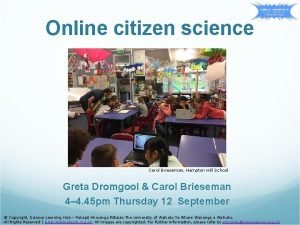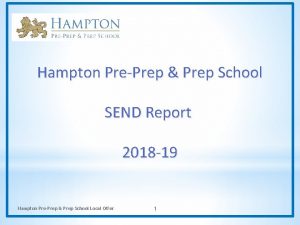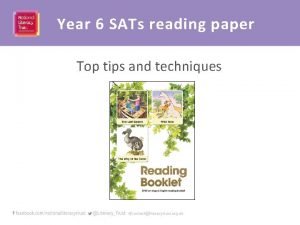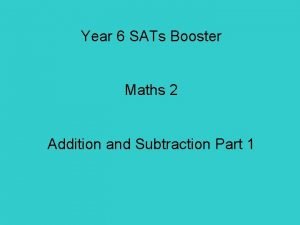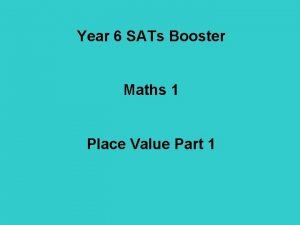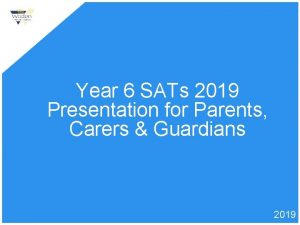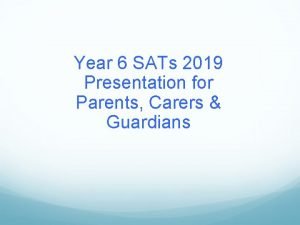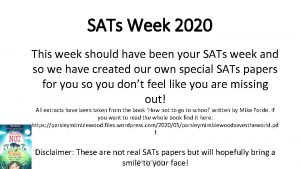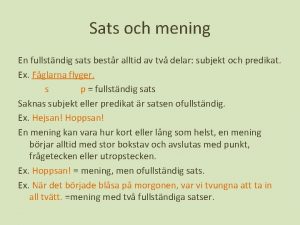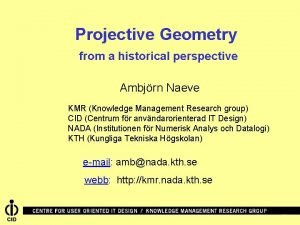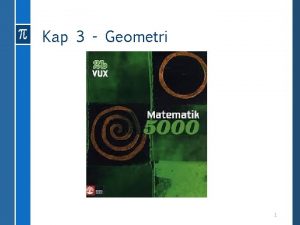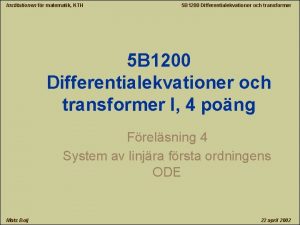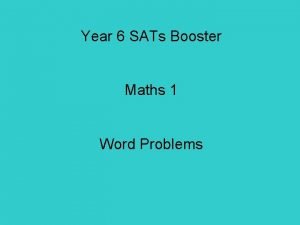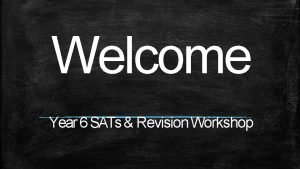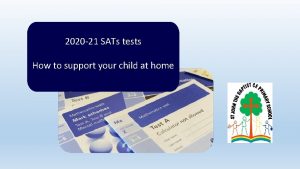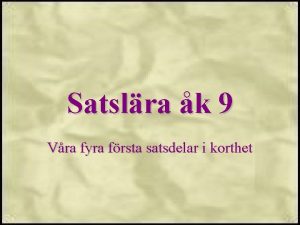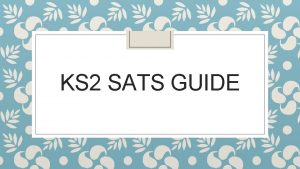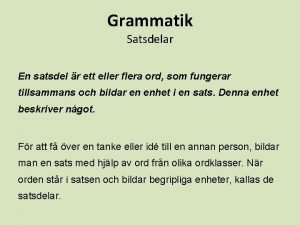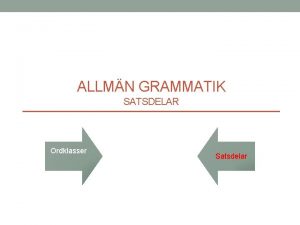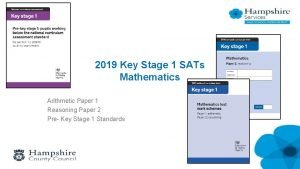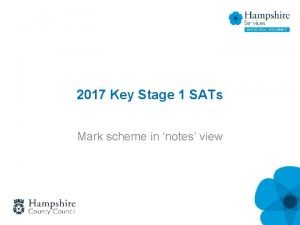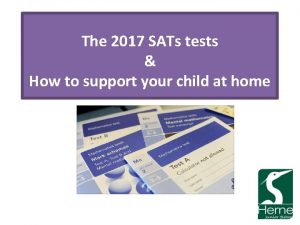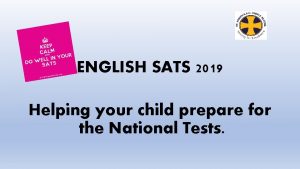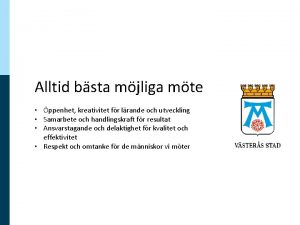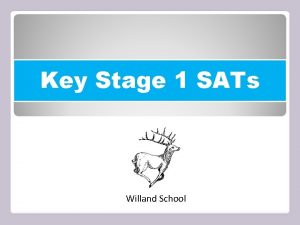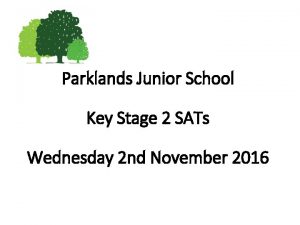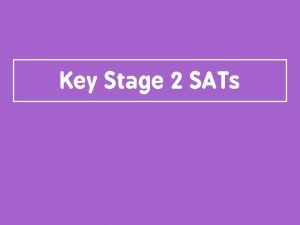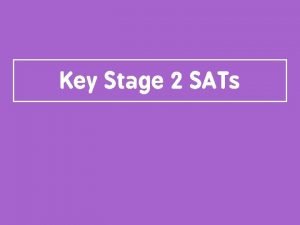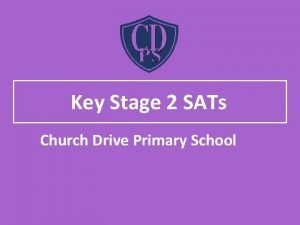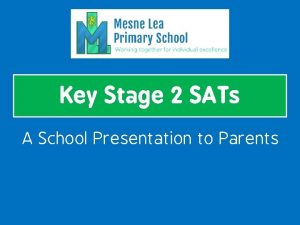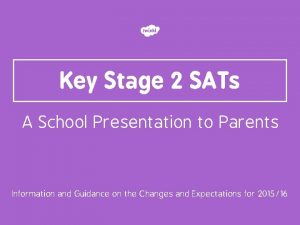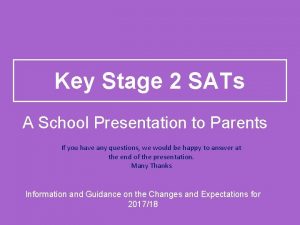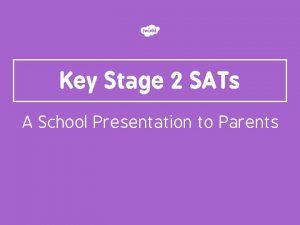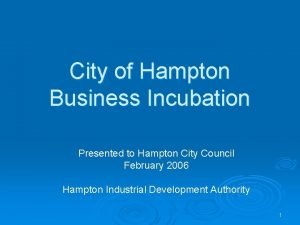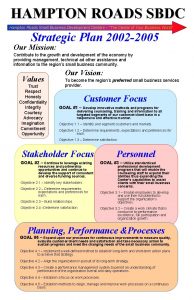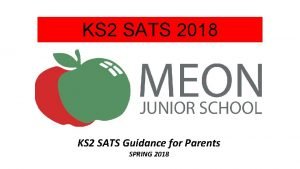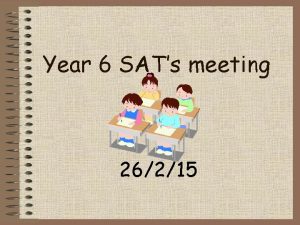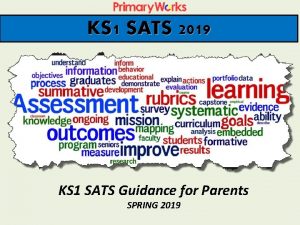Key Stage 2 SATs Hampton Hill Junior School























- Slides: 23

Key Stage 2 SATs Hampton Hill Junior School Wednesday 25 th January 2017 next page

Key Stage 2 SATs Changes • • In a new national curriculum framework was introduced byintroduced the government In 2014/15 a new national curriculum framework was for Years 1, 3, 4 and 5 by the government for Years 1, 3, 4 and 5 • However, Years 2 and 6 (due to statutory testing) continued to study the previous • However, Years 2 andyear. 6 (due to statutory testing) continued to curriculum for one further study the previous curriculum for one further year. • In 2015/16 children in all years at Key Stage 1 and 2 are expected to now study the new national curriculum. • From 2015/16 children in all years at Key Stage 1 and 2 were expected the(Year new 6)national • KS 1 (Year 2)to andstudy KS 2 SATs will reflectcurriculum. the new curriculum for the first time this year. • Last year’s Year 6 pupils were the first to be tested under the new • If your child is in Year 6 this year, they will be the first pupils to receive the new tests system. You may well have heard negative reactions in the media and the first to receive the new style of reporting results. and the assessment is under government review; however the system remains the same for this year. next page

Scaled Score Examples On publication of the test results in Julyresults 2016: On publication of the test in July 2016: • A child awarded a scaled score of 100 is judged to have met the ‘national standard’ in • the Aarea child awarded a scaled score of 100 is judged to have judged by the test. met the ‘national standard’ in the area judged by the test. • A child awarded a scaled score of more than 100 is judged to have exceeded the national standard and demonstrated a higher than expected knowledge of their age. a scaled score of more than 100 is • curriculum A childforawarded to have exceeded and • judged A child awarded a scaled score of lessthe thannational 100 is judgedstandard to have not yet met the national standard and a performed expectation for their age. demonstrated higherbelow than expected knowledge of the curriculum for their age. • A child awarded a scaled score of less than 100 is judged to have not yet met the national standard and performed below expectation for their age. next page

Assessment and Reporting • • ‘Old’ curriculum levels (e. g. Level 3, 4, Level 5) have abolished, as set ‘Old’national curriculum (e. g. 3, now 4, 5)been have now been out in the government guidelines. abolished, as set out in the government guidelines. • From 2016, test scores will be reported as ‘scaled scores’. • This means it is very difficult to compare the assessment of a previous year with the current year. • This means it is very difficult to compare the assessment of a year the current year. expectations and cover all required • previous Your child will stillwith be taught with the highest elements of the curriculum, similar to previous years. • Your child will still be taught with the highest expectations and • The new curriculum is more rigorous and sets high expectations which all schools cover all required elements of the curriculum, similar to previous have had to work hard to meet since the beginning of last years. • The new curriculum is more rigorous and sets high expectations which all schools have had to work hard to meet since the beginning of last year. next page

Scaled Scores Whatisismeant ‘scaled scores’? • • What byby ‘scaled scores’? • • It 100 will always represent the ‘national standard’. It isisplannedthat 100 always represent the ‘national standard’. • • Each test score will therefore be converted into a score onscore the scale, Eachpupil’sraw test score therefore be converted into a on the either above below or 100. scale, at, either at, orabove below 100. • The scale will have a lower end point somewhere below 100 and an upper end point • above The scale 100. will have a lower end point somewhere below 100 and an upper end point above 100. • A child who achieves the ‘national standard’ (a score of 100) will be judged to have sufficientthe knowledge in standard’ the areas assessed tests. • demonstrated A child who achieves ‘national (a scorebyofthe 100) will be judged to have demonstrated sufficient knowledge in the areas assessed by the • In July 2016 for the first publication of test results, each pupil will receive: tests. • A raw score (number of raw marks awarded). • A scaled score in each tested subject. • From July 2016 (the first publication of test results under the new system) • Confirmation of whether or not they attained the national standard. each pupil will receive: • A raw score (number of raw marks awarded). • A scaled score in each tested subject. • Confirmation of whether or not they attained the national standard. next page

Higher Attaining Pupils • • Previous Key Stage 2 Stage tests were aimed atwere childrenaimed achievingat Levels 3 -5 (with a Previous Key 2 tests children national expectation to reach at least Level 4) achieving Levels 3 -5 (with a national expectation to • In the past, additional Level 6 4) tests were produced for children who demonstrated reach at least Level higher than expected attainment, above Level 5. • • From thispast, year, there won’t be any. Level separate for the mostproduced able children. for In the additional 6 tests were children demonstrated higher • Instead, eachwho test will have scope for higher attainingthan pupils expected to show their strengths. attainment, above Level 5. • From 2016, there won’t be any separate tests for the most able children. • Instead, each test will have scope for higher attaining pupils to show their strengths. next page

The Tests • Key Stage 2 SATs take place nationally in the week commencing 8 th 9 th May 2017. 2016. • Statutory tests will be administered in the following subjects: • Reading (60 minutes) • Spelling (approximately 15 minutes) • Punctuation, Vocabulary and Grammar (45 minutes) • Mathematics - Paper 1: Arithmetic (30 minutes) - Paper 2: Reasoning (40 minutes) - Paper 3: Reasoning (40 minutes) • In addition, some schools will be required to take part in Science testing, consisting of three tests in Biology, Physics and Chemistry. Not all schools will take part in this sampling, which takes place on a later date. • All tests are externally marked. • Writing will be ‘Teacher Assessed’ internally, as in recent years. next page

The Test dates • . Key Stage 2 SATs take place nationally in the week commencing 9 th May 2016. • Statutory tests will be administered in the following subjects: • Reading (60 minutes) • Spelling (approximately 15 minutes) • Punctuation, Vocabulary and Grammar (45 minutes) • Mathematics - Paper 1: Arithmetic (30 minutes) - Paper 2: Reasoning (40 minutes) - Paper 3: Reasoning (40 minutes) • In addition, some schools will be required to take part in Science testing, consisting of three tests in Biology, Physics and Chemistry. Not all schools will take part in this sampling, which takes place on a later date. • All tests are externally marked. • Writing will be ‘Teacher Assessed’ internally, as in recent years. next page

Mathematics • The Mathematics tests have undergone the biggest change this year. • Children will sit three tests: Paper 1, Paper 2 and Paper 3. • Paper 1 is for ‘Arithmetic’ lasting for 30 minutes, covering calculation methods for all operations, includingpercentages use of fractions, percentages and all operations, including use of fractions, and decimals. • Questions gradually increase in difficulty. Not all children will be expected to access • Questions increase in difficulty. Not all children will be expected some of thegradually more difficult questions later in the paper. to access some of the more difficult questions later in the paper. • Papers 2 and 3 cover ‘Problem Solving and Reasoning’, each lasting for 40 minutes. • Papers 2 and 3 cover ‘Problem Solving and Reasoning’, each lasting for 40 • Pupils will still require calculation skills but will need to answer questions in context minutes. and decide what is required to find a solution. • Pupils will still require calculation skills but will need to answer questions in context and decide what is required to find a solution. next page

Sample Questions Maths Paper 1: Arithmetic next page

Sample Questions Maths Paper 2 / Paper 3 : Reasoning next page

Sample Questions Maths Paper 2 / Paper 3 : Reasoning next page

Reading • • The Test consists of a single papertest withpaper three unrelated reading texts. The. Reading Test consists of atest single with three unrelated reading texts. • Children are given 60 minutes in total, which includes reading the texts and answering the questions. • Children are given 60 minutes in total, which includes reading the • A total and of 50 answering marks are available. texts the questions. • Questions are designed to assess the comprehension and understanding of a child’s • A total of 50 marks are available. reading. • • Some questions multiple choice or selected response, others require Questions areare designed to assess the comprehension and short answers and some require an extended response or explanation. understanding of a child’s reading. • Some questions are multiple choice or selected response, others require short answers and some require an extended response or explanation. next page

Spelling, Punctuation and Grammar • • A Spelling test is administered containing 20 words, lasting approximately 15 A Spelling test is administered containing 20 words, minutes. lasting approximately 15 minutes. • A separate test is given on Punctuation, Vocabulary and Grammar • • A separate is given on Punctuation, Vocabulary and This test lasts fortest 45 minutes and requires short answer questions, including some multiple choice. Grammar • Marks for these two tests are added together to give a total for Spelling, Grammar. • Punctuation This testand lasts for 45 minutes and requires short answer questions, including some multiple choice. • Marks for these two tests are added together to give a total for Spelling, Punctuation and Grammar. next page

Sample Questions Grammar, Punctuation and Spelling Paper 1 next page

Sample Questions Grammar, Punctuation and Spelling Paper 1 next page

How to Help Your Child First and reassure your child that there is nothing to worry • First andforemost, support and reassure your child there is nothing to about they should try their Praise and. Praise encourage! worry and about and they always shouldjust always just best. try their best. and encourage! • • Ensure possible attendance at school Ensure yourchildhas hasthe thebest possible attendance at school. • • Support tasks. Supportyourchildwithany anyhomework tasks. • Reading, spelling and arithmetic (e. g. times tables) are always good to practise. • Talk to your child about what they have learnt at school and what book(s) they are • Talk to your child about what learnt at school and what book(s) they reading (the character, the plot, they theirhave opinion). are reading (the character, the plot, their opinion). • Make sure your child has a good sleep and healthy breakfast every morning! next page

How to Help Your Child with Reading • Listening to your child read can take many forms. • First and foremost, focus developing an enjoyment and love of reading. • Enjoy stories together – reading stories to your child at KS 1 and KS 2 is equally as important as listening to your child read. • Read a little at a time but often, rather than rarely but for long periods of time! • Talk about the story before, during and afterwards – discuss the plot, the characters, their feelings and actions, how it makes you feel, predict what will happen and encourage your child to have their own opinions. • Look up definitions of words together – you could use a dictionary, the internet or an app on a phone or tablet. • All reading is valuable – it doesn’t have to be just stories. Reading can involve anything from fiction and non-fiction, poetry, newspapers, magazines, football programmes, TV guides. Remember to use Bug Club too! • Visit the local library - it’s free! next page

How to Help Your Child with Writing • Practise and learn weekly spelling lists – make it fun! • Encourage opportunities for writing such as letters to family or friends, shopping Use Grammar and Spelling Bug. lists, notes or reminders, stories or poems. • Encourage opportunities for writing such as letters to family or friends, shopping • lists, Writenotes together – be a good role model for writing. or reminders, stories or poems. • Encourage use of a dictionary tomodel check for spelling and a thesaurus to find synonyms Write together – be a good role writing. and expand vocabulary • Encourage use of a dictionary to check spelling and a thesaurus to find synonyms • and Allow your child to use a computer for word processing, which will allow for editing expand vocabulary and correcting of errors without lots of crossing out. • Allow your child to use a computer for word processing, which will allow for editing • and Remember thatofgood readers become writers! correcting errors without lots ofgood crossing out. Identify good writing features when reading (e. g. vocabulary, sentence structure, punctuation). • Remember that good readers become good writers! Identify good writing features • when Show reading your appreciation: praisesentence and encourage, evenpunctuation). for small successes! (e. g. vocabulary, structure, • Show your appreciation: praise and encourage, even for small successes! next page

How to Help Your Child with Maths • Play times tables games and use Mathletics frequently • Play Use activities mental maths set ongames Activeincluding Learn to counting consolidate in different learning in amounts, class forwards and backwards • Encourage opportunities for telling the time • Encourage opportunities for counting coins and money; finding amounts or • calculating Encourage opportunities change when shopping for counting coins and money; finding amounts or calculating change when shopping • Look for examples of 2 D and 3 D shapes around the home and identify their • properties Look for numbers on street signs, car registrations and anywhere else! • Identify, Look for weigh examples or measure of 2 D andquantities 3 D shapes and around amounts the home in the kitchen or in recipes • Identify, Play games weigh involving or measure numbers quantities or logic, and suchamounts as dominoes, in thecard kitchen games, or indarts, recipes draughts or chess • Play games involving numbers or logic, such as dominoes, card games, darts, • Use draughts the CGP or chess revision guides to target topics that your child is less confident with • Check homework and go through questions together to clarify understanding next page

Access arrangements A small number of pupils may need additional arrangements in order to take part in the SATs. This support must not be an advantage or disadvantage to pupils. We will be required to document and demonstrate pupil eligibility for any access arrangements. S c r i b e s T r a n s c r i p t s These arrangements are for: • Children with a disability or sensory impairment • Children with SEND • Children with behavioural, emotional or social difficulties • Children with English as an Additional Language They arrangements can include access to: • Scribes, transcripts or electrical aids • Readers, prompters or rest breaks • written or oral translations • Apparatus in mathematics tests • Modified test papers U s e o f w o r d p r o c e s s o r e l e c t r i c a l a i d s next page

Play times games • • The SATstables are an opportunity for every child to do their very best- the Y 6 team will support them throughout this process. • Play mental maths games including counting in different amounts, forwards and • Our School Association have kindly provided revision guides and backwards workbooks for the children. Encourage opportunities for telling the time. Y 6 curriculum in Year 6 - whilst • • We will maintain a lively and varied integrating the requirements of the National Tests. • Encourage opportunities for counting coins and money; finding amounts or calculating change when shopping • The best possible attendance of all Y 6 pupils is essential- in order to • Look for numbers on street signs, car registrations and anywhere else! fully benefit from the preparation and support that is planned. Look fordo examples of 2 D any and 3 D shapes (or around the home • • Please not make medical other) appointments during the SATS. • Identify, weigh or measure quantities and amounts in the kitchen or in recipes • Play games involving numbers or logic, such as dominoes, card games, darts, draughts or chess next page

 Hampton hill school
Hampton hill school Hampton pre prep school
Hampton pre prep school Sats revision tips
Sats revision tips Sats booster maths
Sats booster maths Sats booster maths
Sats booster maths Year 6 sats 2019
Year 6 sats 2019 Year 6 sats 2019
Year 6 sats 2019 Sats week
Sats week Bisatser
Bisatser Steiner sats
Steiner sats Parallelltransversal
Parallelltransversal Sats transformer
Sats transformer Sats word problems
Sats word problems Sats 2019 timetable
Sats 2019 timetable Sats tests 2020
Sats tests 2020 Ofullständig sats
Ofullständig sats What are sats
What are sats Skillnaden mellan ordklasser och satsdelar
Skillnaden mellan ordklasser och satsdelar Att-satser
Att-satser Ks1 sats papers 2019
Ks1 sats papers 2019 2017 sats mark scheme
2017 sats mark scheme Sats 2017 reading paper
Sats 2017 reading paper How to prepare your child for sats
How to prepare your child for sats Sats västerås
Sats västerås
